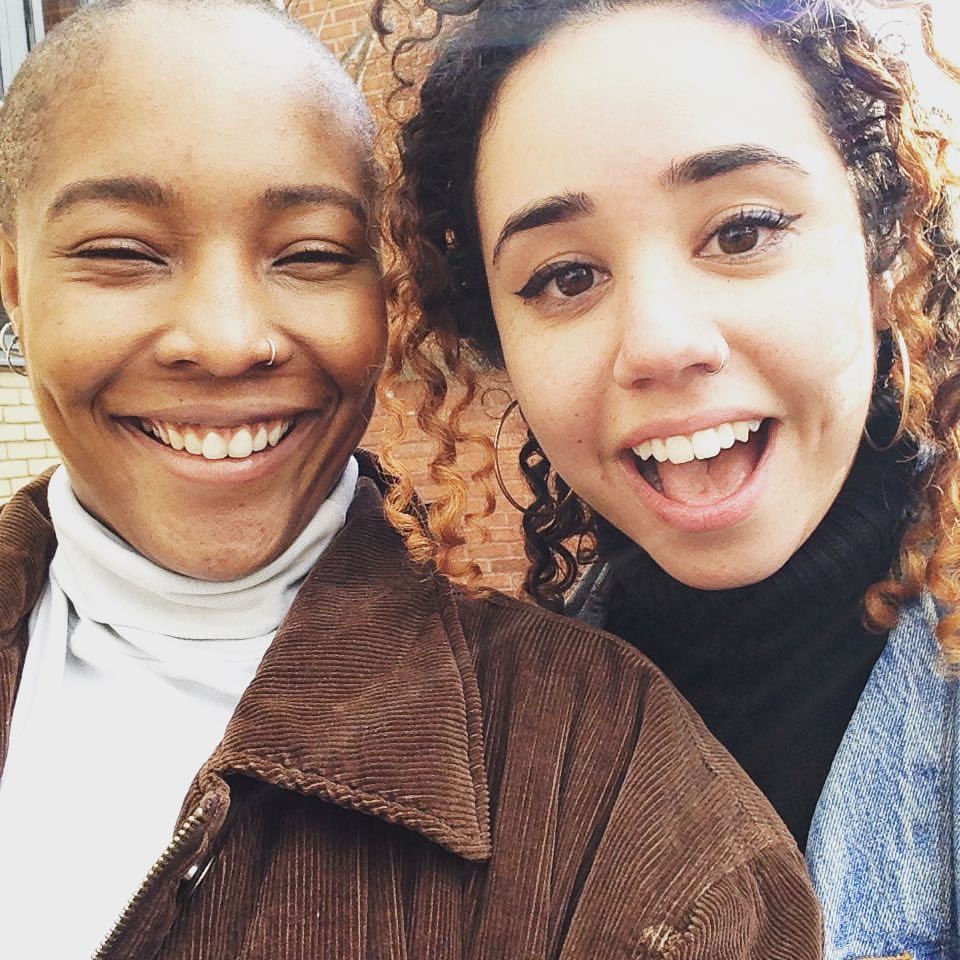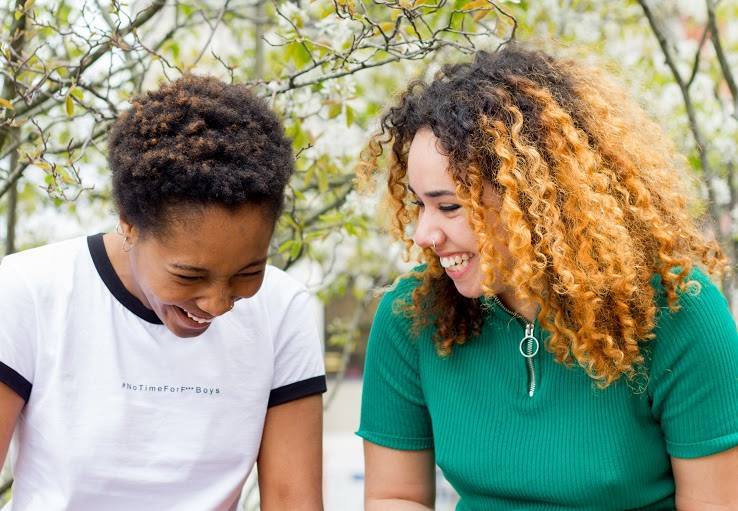Diversity has become a hot topic of conversation. But unless words turns into actions, the issues surrounding the lack of inclusivity in society will fail to be recognized. This is no more prevalent that in the world of media, where statistics show an overwhelming bias towards white males in positions of power in British journalism. A recent survey conducted by City University estimated that just 0.4% of British journalists are Muslim and only 0.2% are black despite 5% of the UK population being Muslim and 3% black. It is imperative that media reflects the concerns and stories people of color have, while not only encouraging tolerance and understanding but meeting the needs of our ever-growing, diverse culture.
Frustrated with the stats being filtered down into the type of stories she was reading, 22-year-old Liv Little teamed up with friend Leyla Reynolds, (who she met on a politics course at The University of Bristol), to set up gal-dem in September 2015. Liv hails from south London and serves as Editor-in-Chief while Ipswich-born Leyla acts as Culture Editor. Though the site is only eight months old, the girls have already rallied a pool of over 60 contributors from all over the world to tell the stories that are missing from the mainstream.
How did you come up with the name for gal-dem?
Liv: I was looking for phrases which summed up girlhood and female friendship from my south east London upbringing. I was on Urban Dictionary comparing the different terms we used to use to refer to our girl friends and “gal-dem” was the first to come up. I wasn’t sure what people would think at first, but I put the feelers out and it seemed to resonate. I had the name before I had a fully developed idea of what gal-dem would be.
What were your interactions with mainstream media growing up?
Leyla: Mainstream media is unrepresentative; I think I’d always realized this and it hadn’t particularly upset me, maybe because I was quite a self-satisfied child. My mom never let me straighten my hair or anything, even when I so desperately wanted to, so to an extent I’d already let go of some of those mainstream beauty ideals. But as I got older I did start to question why it was the case that there was only one kind of woman represented in the media — how damaging and limiting it is, in particular for young girls whose insecurities are immediately pounced upon as they hit puberty as a target for product marketing.
Who are some of the people you look up to?
Leyla: Mainly all the creatives thriving online who I find through places like Instagram. I’m such a fan of Insta in finding people like Monica Kim Garza, Polly Nor, and Frances Cannon who are such talented artists and are fab at representing all the different kinds of woman that you can be. And obvs Liv everyday!
Liv: The babes who are inspiring me at the moment are Adwoa Aboah, Zahra Swanzy, and Peatree Bojangles as they’re all carving out creative niches for women. I think it’s so important to have young women like that to look up to — women who are unapologetically taking up space. And Solange, always Solange.
What frustrated you most about mainstream media?
Liv: Most of my frustrations started within academia to be honest, where the experiences of women of color in feminism were rarely talked about; everything was skimmed over and I was getting pretty pissed off with the structure of things. But then, of course, this is the same stuff which you see on mainstream media outlets; I mean look at Piers Morgan and his critique of Beyonce’s Lemonade — “I never like it when entertainers go all political.” Of course the Daily Mail is the worst but it does reflect the issues which media outlets have in terms of black women unapologetically asserting their presence. It wasn’t so much that I had read a lot of damning things, it was more a lack of inclusion which acted as a catalyst for launching gal-dem.
Where do you find your pool of contributors?
Liv: Initially, I put out call-outs in networking groups for women of color and at my university and that’s where I met some of the main baes. Leyla and [Music Editor] Antonia were some of the first to get involved. After the core team was established and we had an online following, people started to get in touch. Now we have about 60 contributors from all over the UK, US, Europe, and Canada.
Good or bad, could you tell us about some of the feedback gal-dem has received?
Leyla: There’s been some pretty hilarious comments — some just demonstrating a basic lack of understanding of the issues that women of color face on a daily basis, but I guess that just demonstrates how much of a need there is for the content that gal-dem produces. Mainly it’s really positive, people saying that we’re articulating things that they wish were tackled by mainstream outlets which makes us feel pretty great.
Liv: We get the most heartfelt responses from women of color, many who have reached out and said how happy they are that we exist, and how many of our pieces have resonated with them on a personal level. It’s a beautiful thing for those reading and writing articles to connect in such a deep and meaningful way.
Leyla: We’ve been called whiny lefty liberals by a few publications, particularly after our skin lightening campaign, where people rallied in support of Emma Watson. The focus on the series wasn’t on her, but it got picked up and some of the coverage which ensued was pretty awful. And then we get all the usual horrible racist comments, people calling us monkeys and telling us to get back to where we came from. 95% of our comments are overwhelmingly positive, and I guess trolls are to be expected.

You’ve said in the past that it annoys you that black female journalists will be commissioned to write a piece about black hair but not for anything else. In the same breath, it can be argued that these are important conversations to be having and putting into the mainstream. How do you balance things out?
Liv: It’s tricky. We do want to have these conversations in the mainstream, but it’s all about balance. Of course, issues which affect women of color should be written about by women of color on mainstream platforms in an authentic manner. I think the problem arises when those are the only pieces commissioned to those people. We should be able to write about the politics of black hair in one breath and in the other pen an article about something positive, or funny. Writing is a brilliant way to raise awareness around these issues but, as with anything, it can get too much when they are the only aspects which are showcased.
With people having more frank and open conversations about race in 2016, has it made gal-dem an easier thing to set up?
Liv: I remember my mom saying that this was the right time for such a platform to exist — and it is. The internet has opened up these sorts of conversations, spaces, and collectives which has definitely impacted on setting up gal-dem. There was definitely a gap in the market for what we are doing and so people have been super responsive to us — people from all walks of life, which is great!
Leyla: In my opinion it’s the increase in media outlets like gal-dem and other publications like Skin Deep that have facilitated a more nuanced conversation about race and gender in popular media. But yes, I also think that with movements like #blacklivesmatter and the omnipresence of social media, wider society is having a tough time ignoring the issues that were previously conceived of as niche, taboo, or unnecessary for heavy contemplation. It’s important that these issues are being talked about but there’s also a tendency to assume that because you and your friends are having an open conversation about race that the rest of society is also now comfortable with it. We need to make sure that mainstream media sources acknowledge the necessity of covering race and not simply leaving it to publications like gal-dem.
In your opinion, what are some of the direct effects of not having a more diverse media?
Leyla: It means a lack of positive role models for teenagers and young women of color. It also means a lack of narrative in the media and a duller, narrower breadth of experience — which not only harms the women of color but an enormous swathe of the population. Recently we’ve published articles on the harmful but widespread effects of skin lightening and on the rarely talked about question of body hair for women of color. I don’t remember reading anything about these issues in the beginning of online feminism. If you can’t always relate to the stuff that you’re constantly bombarded with — and that’s what the case is now with social media — then you feel like your experiences aren’t legitimate.
How does gal-dem look to be inclusive to all minorities?
Liv: It’s a platform used to share the diverse body of experiences amongst a small sample of young women of color. We are here to learn from, debate, and discuss our various lived experiences. Through representing a plethora of voices, the aim of gal-dem is to hammer home the fact that not all women of color think or feel the same. So it’s inclusive for women of color in that way, but it’s also inclusive in that you don’t have to be black/white, man/woman, gay/straight to read our content; the content is well written and speaks for itself.
How would you advise brands and media on becoming more inclusive?
Liv: Hire more women of color; diversity breeds creativity and it’s good for business too. It isn’t like talented women of color don’t exist, it’s that they aren’t given the same scale of platforms as their white counterparts. It’s not the role of women of color to have to beg for inclusion; we deserve to take up space and brands should recognize that. We shouldn’t be an afterthought.
How would you like gal-dem to evolve and grow?
Liv: I really want us to grow post-graduation. I’m taking the year to focus on gal-dem and I’d love for us to grow into a fully functioning publication with a work space and the money to work on it full time. It’s been great but also a bit of struggle balancing everything alongside studying!
Credits
Text Lynette Nylander
Photography Ailsa Fineron
